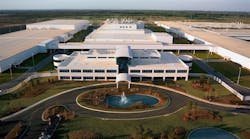For almost a century, life in Alexander City, Alabama, revolved around Russell Corp. The athletic-wear maker was headquartered in the town of 15,000, and employed 7,200 people there.
“I became mayor in 1996, and all the mayor of Alex City had to do was please Russell, to be honest,” recalled Don McClellan when I visited last Tuesday.
In 1998, Russell announced that it was cutting 4,000 jobs and shifting production abroad. The job cuts continued after that, the result partly of broader apparel industry trends but also of Russell’s struggles to compete with Nike, Adidas and upstart Under Armour. Russell moved its headquarters to Atlanta, then sold itself to Berkshire Hathaway in 2006. Its only remaining presence in Alex City is a warehouse and distribution center that employs 400.
When a community loses an old-line manufacturing mainstay like that, the two story lines we've learned to expect are that:
The town falls apart, or
It reinvents itself for the post-industrial era, attracting tourists, immigrants, hipsters, call centers, maybe even startups.
In parts of Alabama in the 2000s, though, it turned out there was another viable option: find new manufacturing mainstays. In 2001, Honda opened an automobile plant about an hour and 15 minutes drive north of Alex City. In 2005, Hyundai opened one the same distance to the south. In 2010, Kia opened one the same distance to the east, just over the Georgia state line. And Alex City went on the hunt for auto-parts manufacturers that supplied these plants (along with anybody else willing to hire people).
The regional Lake Martin Area Economic Development Alliance -- set up in 1998 as the Russell troubles began and headed since 2004 by McClellan -- has so far brought in 16 new employers and 4,000 new jobs, most of them at six auto-parts manufacturers.
Clearly, 4,000 is a lot less than 7,200. Although Russell drew in lots of workers from surrounding towns, it’s now the auto assembly plants elsewhere that exert a magnetic force. Losing the headquarters of a New York Stock Exchange-listed corporation has certainly changed Alex City (Hanna Rosin wrote a fascinating New York Times article four years ago about the consequences for gender relations of Russell’s departure) and to some extent diminished it. Still, 4,000 new jobs have been enough to keep the town going -- especially because most of them pay somewhat better than the old apparel jobs. The city's population has dropped only slightly, from 15,034 in 2000 to 14,718 in 2015.
Alex City isn't going to fall apart, then. It also probably isn't going to reinvent itself as a post-industrial mecca, although the nearby presence of Lake Martin, 44,000-acre reservoir that is a favorite weekend destination for affluent residents of Birmingham and Montgomery, does lead to some incongruous sights like a coffeehouse and a wine store downtown, and the headquarters of Covey Rise magazine (which "celebrates the lifestyle of the upland sporting enthusiast") next to a Dollar General store on State Route 63 south of town.
Instead, Alex City is staking its future on the continued need for people who can make stuff. So, to a great extent, is the state of Alabama -- and several other Southern states. And while last year I wrote that perhaps the South had erred in choosing to double-down on manufacturing just as manufacturing employment collapsed, a week in Alabama has left me wondering. It's not that the prospects for manufacturing employment are all that spectacular, it's just that (a) there is still a good amount of it to go around and (b) what else are people in places like Alex City supposed to do?
Here are the states where manufacturing employment makes up the biggest share of total payroll employment.
It's all states in either the old industrial heartland of the Midwest or the new industrial heartland of the South. Alabama is pretty high on the list, and its reliance on manufacturing has not been painless -- the state had 27 percent fewer manufacturing jobs in September than it did in January 1990. That's still somewhat better, though, than the 31 percent national decline over that period. And when you narrow things down to durable goods manufacturing, the contrast between Alabama and the nation is pretty dramatic:
A large part of this is due to the arrival of the automakers, which started with Mercedes-Benz opening a plant near Tuscaloosa in 1997. As the state's apparel industry collapsed, they helped fill the employment gap.
New heavy manufacturers keep coming: Airbus just started producing airplanes in Mobile last year. Then again, old ones keep going, too: U.S. Steel shut down its venerable blast furnace outside Birmingham last year. Relying on manufacturing remains pretty risky business. But for Alabama and the South, it's not crazy.
By Justin Fox
This column does not necessarily reflect the opinion of the editorial board or Bloomberg LP and its owners.



